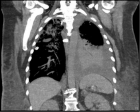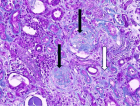Abstract
Research Article
Enhancing functional expression of L-glycerophosphate oxidase in Escherichia coli by controlling the expression rate
Wenyu Zhang, Huanbo Tan, Yuanyuan Du, Yafeng Li, Wencheng Su, Michael Sattler and Peijian Zou*
Published: 04 July, 2022 | Volume 6 - Issue 1 | Pages: 008-013
Heterologous expression of proteins often pursues high expression levels, but it can easily result in misfolding and loss of biological function. L-α-glycerophosphate oxidase (GlpO) is a flavin adenine dinucleotide (FAD)-dependent oxidase which is widely used in the clinical determination of triglycerides. We found that the total enzymatic activity of GlpO expressed in Escherichia coli (E. coli) was extremely low, probably due to the absence of FAD cofactors and the misfolding of GlpO at a high synthesis rate. Therefore, decreasing the expression rate was used to improve the activity of GlpO. The specific activity of GlpO expressed on the pUC19 vector with lac promotor was approximately 30 times higher than that expressed on the pET28a vector with T7 promotor, but the expression levels of GlpO on the two vectors were completely opposite. It indicated that the specific activity of GlpO was increased as the expression level decreased. However, too low expression greatly influences the total amount and activity of the functional enzyme. In order to resolve this problem, two new plasmids, GlpO-CG4 and GlpO-CG6, were constructed by inserting 4 or 6 nucleotides, respectively, between the ribosome binding site (RBS) and the start code (ATG) on pET28a. Compared with the expression on the GlpO-pET vector, the expression rates of GlpO on the GlpO-CG4 and GlpO-CG6 were dramatically decreased. The total activity of GlpO expressed on GlpO-CG6 was 11 times and 1.5 times higher than that expressed on the GlpO-pET and GlpO-pUC, respectively. Results suggest that the activity of GlpO can be improved by decreasing the expression rate.
Read Full Article HTML DOI: 10.29328/journal.abse.1001016 Cite this Article Read Full Article PDF
Keywords:
Glycerophosphate oxidase; Expression level; Specific activity; Lac promoter; Ribosome binding site
References
- Maenpuen S, Watthaisong P, Supon P, Sucharitakul J, Parsonage D, Karplus PA, Claiborne A, Chaiyen P. Kinetic mechanism of L-α-glycerophosphate oxidase from Mycoplasma pneumoniae. FEBS J. 2015 Aug;282(16):3043-59. doi: 10.1111/febs.13247. Epub 2015 Mar 20. PMID: 25712468.
- Hames C, Halbedel S, Hoppert M, Frey J, Stülke J. Glycerol metabolism is important for cytotoxicity of Mycoplasma pneumoniae. J Bacteriol. 2009 Feb;191(3):747-53. doi: 10.1128/JB.01103-08. Epub 2008 Nov 21. PMID: 19028882; PMCID: PMC2632104.
- Elkhal CK, Kean KM, Parsonage D, Maenpuen S, Chaiyen P, Claiborne A, Karplus PA. Structure and proposed mechanism of L-α-glycerophosphate oxidase from Mycoplasma pneumoniae. FEBS J. 2015 Aug;282(16):3030-42. doi: 10.1111/febs.13233. Epub 2015 Mar 14. PMID: 25688572.
- Schumacher M, Nicholson P, Stoffel MH, Chandran S, D'Mello A, Ma L, Vashee S, Jores J, Labroussaa F. Evidence for the Cytoplasmic Localization of the L-α-Glycerophosphate Oxidase in Members of the "Mycoplasma mycoidesCluster". Front Microbiol. 2019 Jun 19;10:1344. doi: 10.3389/fmicb.2019.01344. PMID: 31275271; PMCID: PMC6593217.
- Staerck C, Wasselin V, Budin-Verneuil A, Rincé I, Cacaci M, Weigel M, Giraud C, Hain T, Hartke A, Riboulet-Bisson E. Analysis of glycerol and dihydroxyacetone metabolism in Enterococcus faecium. FEMS Microbiol Lett. 2021 May 6;368(8):fnab043. doi: 10.1093/femsle/fnab043. PMID: 33864460.
- Charrier V, Luba J, Parsonage D, Claiborne A. Limited proteolysis as a structural probe of the soluble alpha-glycerophosphate oxidase from Streptococcus sp. Biochemistry. 2000 May 2;39(17):5035-44. doi: 10.1021/bi992499j. PMID: 10819968.
- MacKová M, Kost'Al J, Demnerová K. Properties and stability of glycerophosphate oxidase isolated from a mutant strain of Aerococcus viridans. Lett Appl Microbiol. 2000 Mar;30(3):188-91. doi: 10.1046/j.1472-765x.2000.00690.x. PMID: 10747248.
- Pilo P, Vilei EM, Peterhans E, Bonvin-Klotz L, Stoffel MH, Dobbelaere D, Frey J. A metabolic enzyme as a primary virulence factor of Mycoplasma mycoides subsp. mycoides small colony. J Bacteriol. 2005 Oct;187(19):6824-31. doi: 10.1128/JB.187.19.6824-6831.2005. PMID: 16166545; PMCID: PMC1251598.
- Blötz C, Stülke J. Glycerol metabolism and its implication in virulence in Mycoplasma. FEMS Microbiol Rev. 2017 Sep 1;41(5):640-652. doi: 10.1093/femsre/fux033. PMID: 28961963.
- Nagaraju R, Joshi AK, Rajini PS. Estimation of plasma triglycerides with correction for free glycerol by orlistat inhibition of lipoprotein lipase activity. Anal Biochem. 2013 Aug 1;439(1):44-6. doi: 10.1016/j.ab.2013.04.008. Epub 2013 Apr 15. PMID: 23597845.
- Streitenberger SA, López-Mas JA, Sánchez-Ferrer A, García-Carmona F. Highly efficient Aerococcus viridans L-alpha-glycerophosphate oxidase production in the presence of H2O2-decomposing agent: purification and kinetic characterization. Appl Microbiol Biotechnol. 2001 Oct;57(3):329-33. doi: 10.1007/s002530100664. PMID: 11759680.
- Menzella HG. Comparison of two codon optimization strategies to enhance recombinant protein production in Escherichia coli. Microb Cell Fact. 2011 Mar 3;10:15. doi: 10.1186/1475-2859-10-15. PMID: 21371320; PMCID: PMC3056764.
- Mauro VP. Codon Optimization in the Production of Recombinant Biotherapeutics: Potential Risks and Considerations. BioDrugs. 2018 Feb;32(1):69-81. doi: 10.1007/s40259-018-0261-x. PMID: 29392566.
- Blazeck J, Alper HS. Promoter engineering: recent advances in controlling transcription at the most fundamental level. Biotechnol J. 2013 Jan;8(1):46-58. doi: 10.1002/biot.201200120. Epub 2012 Aug 14. PMID: 22890821.
- Mutalik VK, Guimaraes JC, Cambray G, Lam C, Christoffersen MJ, Mai QA, Tran AB, Paull M, Keasling JD, Arkin AP, Endy D. Precise and reliable gene expression via standard transcription and translation initiation elements. Nat Methods. 2013 Apr;10(4):354-60. doi: 10.1038/nmeth.2404. Epub 2013 Mar 10. PMID: 23474465.
- Cheong DE, Ko KC, Han Y, Jeon HG, Sung BH, Kim GJ, Choi JH, Song JJ. Enhancing functional expression of heterologous proteins through random substitution of genetic codes in the 5' coding region. Biotechnol Bioeng. 2015 Apr;112(4):822-6. doi: 10.1002/bit.25478. Epub 2015 Jan 16. PMID: 25323933.
- Mirzadeh K, Martínez V, Toddo S, Guntur S, Herrgård MJ, Elofsson A, Nørholm MH, Daley DO. Enhanced Protein Production in Escherichia coli by Optimization of Cloning Scars at the Vector-Coding Sequence Junction. ACS Synth Biol. 2015 Sep 18;4(9):959-65. doi: 10.1021/acssynbio.5b00033. Epub 2015 May 15. PMID: 25951437.
- Parret AH, Besir H, Meijers R. Critical reflections on synthetic gene design for recombinant protein expression. Curr Opin Struct Biol. 2016 Jun;38:155-62. doi: 10.1016/j.sbi.2016.07.004. Epub 2016 Jul 21. PMID: 27449695.
- Liebeton K, Lengefeld J, Eck J. The nucleotide composition of the spacer sequence influences the expression yield of heterologously expressed genes in Bacillus subtilis. J Biotechnol. 2014 Dec 10;191:214-20. doi: 10.1016/j.jbiotec.2014.06.027. Epub 2014 Jul 2. PMID: 24997355.
- Wang M, Kaufman RJ. Protein misfolding in the endoplasmic reticulum as a conduit to human disease. Nature. 2016 Jan 21;529(7586):326-35. doi: 10.1038/nature17041. PMID: 26791723.
- Zheng C, Zhao Z, Li Y, Wang L, Su Z. Effect of IPTG amount on apo- and holo- forms of glycerophosphate oxidase expressed in Escherichia coli. Protein Expr Purif. 2011 Feb;75(2):133-7. doi: 10.1016/j.pep.2010.08.009. Epub 2010 Aug 22. PMID: 20736068.
- Savino S, Meijer JDM, Rozeboom HJ, van Beek HL, Fraaije MW. Kinetic and structural properties of a robust bacterial L-amino acid oxidase. 2021; 11: 1309.
- Shilling PJ, Mirzadeh K, Cumming AJ, Widesheim M, Köck Z, Daley DO. Improved designs for pET expression plasmids increase protein production yield in Escherichia coli. Commun Biol. 2020 May 7;3(1):214. doi: 10.1038/s42003-020-0939-8. PMID: 32382055; PMCID: PMC7205610.
- Sibley M, Ward JM. A cell engineering approach to enzyme-based fed-batch fermentation. Microb Cell Fact. 2021 Jul 24;20(1):146. doi: 10.1186/s12934-021-01634-y. PMID: 34303374; PMCID: PMC8310608.
- Tuller T, Zur H. Multiple roles of the coding sequence 5' end in gene expression regulation. Nucleic Acids Res. 2015 Jan;43(1):13-28. doi: 10.1093/nar/gku1313. Epub 2014 Dec 12. PMID: 25505165; PMCID: PMC4288200.
- Wakabayashi H, Warnasooriya C, Ermolenko DN. Extending the Spacing between the Shine-Dalgarno Sequence and P-Site Codon Reduces the Rate of mRNA Translocation. J Mol Biol. 2020 Jul 24;432(16):4612-4622. doi: 10.1016/j.jmb.2020.06.008. Epub 2020 Jun 13. PMID: 32544497; PMCID: PMC7387212.
Figures:

Figure 1

Figure 2

Figure 3
Similar Articles
-
Enhancing functional expression of L-glycerophosphate oxidase in Escherichia coli by controlling the expression rateWenyu Zhang,Huanbo Tan,Yuanyuan Du,Yafeng Li,Wencheng Su,Michael Sattler,Peijian Zou*. Enhancing functional expression of L-glycerophosphate oxidase in Escherichia coli by controlling the expression rate. . 1899 doi: 10.29328/journal.abse.1001016; 6: 008-013
-
Enhancing functional expression of L-glycerophosphate oxidase in Escherichia coli by controlling the expression rateWenyu Zhang,Huanbo Tan,Yuanyuan Du,Yafeng Li,Wencheng Su,Michael Sattler,Peijian Zou*. Enhancing functional expression of L-glycerophosphate oxidase in Escherichia coli by controlling the expression rate. . 2022 doi: 10.29328/journal.abse.1001016; 6: 008-013
Recently Viewed
-
Fostering Pathways and Creativity Responsible for Advancing Health Research Skills and Knowledge for Healthcare Professionals to Heighten Evidence-Based Healthcare Practices in Resource-Constrained Healthcare SettingsJanvier Nzayikorera*. Fostering Pathways and Creativity Responsible for Advancing Health Research Skills and Knowledge for Healthcare Professionals to Heighten Evidence-Based Healthcare Practices in Resource-Constrained Healthcare Settings. J Community Med Health Solut. 2025: doi: 10.29328/journal.jcmhs.1001052; 6: 005-019
-
Evolution of Antifungal Activity of Artemisia herba-alba Extracts on Growth of Aspergillus sp. and Rhizopus sp.Eman MG Gebreil,Nagwa SA Alraaydi,Saleh HM EL-Majberi,Idress Hamad Attitalla*. Evolution of Antifungal Activity of Artemisia herba-alba Extracts on Growth of Aspergillus sp. and Rhizopus sp.. Int J Clin Microbiol Biochem Technol. 2025: doi: 10.29328/journal.ijcmbt.1001030; 8: 001-006
-
Prevalence and Risk Factors to Preterm Labor through a Study in Jiblah University Hospital, Ibb, Governorate, YemenAfaf Alsharif*,Zainab Said,Fatima Mokabes,Leena Ameen,Alya Alqadri,Thekra Musaed,Bushra Musaed,Ala’a Ahmed,Halaa Rigih. Prevalence and Risk Factors to Preterm Labor through a Study in Jiblah University Hospital, Ibb, Governorate, Yemen. J Community Med Health Solut. 2025: doi: 10.29328/journal.jcmhs.1001053; 6: 020-026
-
Mass Serological Screening in the Armed Forces Using the Serum-Pooling Method. Analytical Evaluation of the Chemiluminescence MethodAbi R*,Ameur O,Hassine S,Chanhih N,Ouannass S,Goura H,Eddaif KH,Elkochri S,Aadi Y,Elbenaissi Y,Tagajdid MR,Elannaz H,Laraqui A,Elmchichi B,Touil N,Kasouati J,Elouennass M,Ennibi K,Lahlou IA. Mass Serological Screening in the Armed Forces Using the Serum-Pooling Method. Analytical Evaluation of the Chemiluminescence Method. Int J Clin Virol. 2025: doi: 10.29328/journal.ijcv.1001062; 9: 001-004
-
Experience of Anesthesiology Residents in the conduct of their Research during Residency Training at Vicente Sotto Memorial Medical CenterShein Melicer Ernacio*,Maria Pura L Rodriguez. Experience of Anesthesiology Residents in the conduct of their Research during Residency Training at Vicente Sotto Memorial Medical Center. Int J Clin Anesth Res. 2025: doi: 10.29328/journal.ijcar.1001026; 9: 001-009
Most Viewed
-
Feasibility study of magnetic sensing for detecting single-neuron action potentialsDenis Tonini,Kai Wu,Renata Saha,Jian-Ping Wang*. Feasibility study of magnetic sensing for detecting single-neuron action potentials. Ann Biomed Sci Eng. 2022 doi: 10.29328/journal.abse.1001018; 6: 019-029
-
Evaluation of In vitro and Ex vivo Models for Studying the Effectiveness of Vaginal Drug Systems in Controlling Microbe Infections: A Systematic ReviewMohammad Hossein Karami*, Majid Abdouss*, Mandana Karami. Evaluation of In vitro and Ex vivo Models for Studying the Effectiveness of Vaginal Drug Systems in Controlling Microbe Infections: A Systematic Review. Clin J Obstet Gynecol. 2023 doi: 10.29328/journal.cjog.1001151; 6: 201-215
-
Causal Link between Human Blood Metabolites and Asthma: An Investigation Using Mendelian RandomizationYong-Qing Zhu, Xiao-Yan Meng, Jing-Hua Yang*. Causal Link between Human Blood Metabolites and Asthma: An Investigation Using Mendelian Randomization. Arch Asthma Allergy Immunol. 2023 doi: 10.29328/journal.aaai.1001032; 7: 012-022
-
Impact of Latex Sensitization on Asthma and Rhinitis Progression: A Study at Abidjan-Cocody University Hospital - Côte d’Ivoire (Progression of Asthma and Rhinitis related to Latex Sensitization)Dasse Sery Romuald*, KL Siransy, N Koffi, RO Yeboah, EK Nguessan, HA Adou, VP Goran-Kouacou, AU Assi, JY Seri, S Moussa, D Oura, CL Memel, H Koya, E Atoukoula. Impact of Latex Sensitization on Asthma and Rhinitis Progression: A Study at Abidjan-Cocody University Hospital - Côte d’Ivoire (Progression of Asthma and Rhinitis related to Latex Sensitization). Arch Asthma Allergy Immunol. 2024 doi: 10.29328/journal.aaai.1001035; 8: 007-012
-
An algorithm to safely manage oral food challenge in an office-based setting for children with multiple food allergiesNathalie Cottel,Aïcha Dieme,Véronique Orcel,Yannick Chantran,Mélisande Bourgoin-Heck,Jocelyne Just. An algorithm to safely manage oral food challenge in an office-based setting for children with multiple food allergies. Arch Asthma Allergy Immunol. 2021 doi: 10.29328/journal.aaai.1001027; 5: 030-037

If you are already a member of our network and need to keep track of any developments regarding a question you have already submitted, click "take me to my Query."
















































































































































